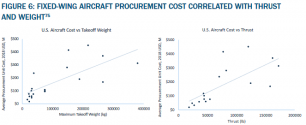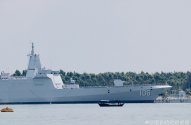I don't want to spend hours explaining all the ways this report is problematic so I'll just start off what you would get in a first impression.
The first thing that jumps out at you when you skim the report is this graph they use. These are linear formulas on non-complex independent variables. Using linear regression like this to explain complex behavior is an immediate red flag.
View attachment 96269
So you take a look at their blurb explaining their choices.
So they picked linear regression despite the issues it has because it is more "explainable". And then they say adjusted it to reflect "holistic assessment" which is another way of saying they pulled it out of their ass.
The report is filled with stuff like this where they are constantly trying to pull a fast one on you. Run this by any data scientist and they would tell you it's a load of bull.
By the way, the formula for the trend lines on the above two graphs are:
Aircraft Cost = $9E-4 * MTOW + 66
Aircraft Cost = $2E-3 * Thrust + 26
Try plugging some known values in there like for B-2 or F-15. The prediction is so far off it's basically nonsense.
These are the sorts of formulas they are using to predict US costs. So if their first step has this much error in it, how much error do you think is in the final result when they try to use it to make relative cost predictions of the Chinese military?
I wasn't that negative about the study when it came out because it seemed like a first step and could potentially lead to something actually useful down the road. That's what the authors of the study seem to think too. But a first step is still a first step on a hundred mile journey. Yet I keep seeing people trying to use this study as an actual data point in discussion. With the level of inaccuracy in this study's results, the actual relative cost could even be 30 J20s to a single Type 052D. I can't stress enough that the error bars here are
enormous. There is basically no useful information that can be gleaned from the report.


